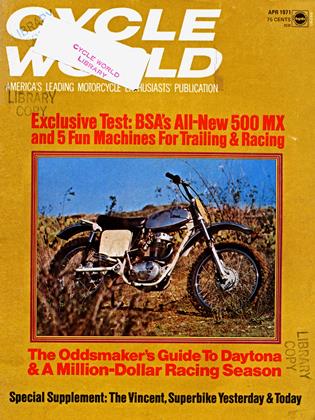HONDA SL125
CYCLE WORLD IMPRESSION
The Honda Singles Are Growing Bigger, But Not Soon Enough To Suit Us.
HONDA'S LATEST ENTRY in the ultra-light weight field seems as though it should have preceeded the SL100 introduced a few months ago. But Honda did practically the same thing by introducing its CB160. and then shortly thereafter its CB175. No logical explanation has drifted our way yet, but as long as the models sell, there can’t be much wrong with the idea.
The dealers' lack of enthusiasm for having to carry spare parts for so many closely related machines, however, seems as though it should have been a factor for the manufacturer to have considered. And yet, each succeeding maChine is superior in its own way and is ultimately justifiable in everyone's eves.
Our reactions to the new SLI 25 were very much like those we'd had towards the highly successful SLIOO tested in the Septemher 1970 issue of CYCLE WORLD. Impression: a lean, trim little machine with "big bike" running gear and handling qualities. Our SLIOO test machine was fitted with a 3.00-21 front tire in place of the standard 3.00-19, helping the handling considerably. Now, the SLI 25 conies w1th a 2.75-21 front tire as standard equipment, and handles almost the same as its smaller brother. A 3.25-I 8 tire is fitted to the rear of the SL125, as opposed to a 3.25-17 on the SLIOO.
We expected the SLI2S to he some what faster and more powerful, but the engine produces only 1/2 horsepower more than the SLIOO at considerably fewer rpm. 1 2 bhp from only 7.5 Cu. in. at 9000 rpm is still an impressive figure, and the lower revs should add up to long engine life, a trait which all Hondas exhibit.
The engine has a chain-driven over head camshaft and features wet sump lubrication. That is, the oil is carried in the crankcase instead of a separate tank. The clutch and transmission compo nents are all carried within the common casting. which is quite oil tight. Five of the slickest shifting gears ever and an ultra-smooth clutch transmit the power to the rear wheel, which contains rubber cushions to smooth out the engine’s firing impulses.
Honda has been a proponent of the “silence is golden’’ theory and the SL125 is no exception. Mechanically, the engine is one of the quietest fourstrokes available, and the muffler/spark arrester emits no more than a whispering burble at any engine speed or load condition. Ecologists take note!
Like its smaller brother, the SL125 suffers a couple of minute handling defects. 1 he machine was designed for a dual purpose, so allowances have to be made. The front forks, with just over 5.5 in. of travel, do their job very well, but the rear suspension is still below par, with sub-standard rebound dampening. Part of this malady is no doubt caused by the insistence of the Japanese upon using fish oil for shock absorber f luid, a job to which it is ill suited. We’d sure like to see an improvement soon.
Instrumentation is very complete with neutral indicator and high beam indicator in the speedometer, and a matching tachometer beside, which is red lined at 9500 rpm. Controls are well laid out and easy to operate. Seating position and the relationship between the seat, handlebars and foot pegs are more like a larger bike, but it’s not so large that it would be difficult for the junior set to manage. Total weight is just a shade under 220 lb. with a half-tank of gas.
With Honda’s mass-production techniques as sophisticated as they are, it’s hard to find fault with the construction of their machines. Paintwork is flawless, welds are smooth and aluminum castings are beautiful. Touches such as the rubber-mounted taillight and the effective bash plate to protect the engine from damage are nice, and the SL125 comes equipped with an off-on-off switch on the twistgrip which can be actuated with the thumb to shut off the engine in case of a mishap. Just below is the headlight switch; one click to the right turns on the lights, while another click in the same direction actuates the high beam.
Brakes are more than adequate for a machine of the SL125's weight and speed potential, and the rear unit features a full-floating backing plate which
is anchored to a point just below the swinging arm pivot bolt, as on a few expensive motocross machines. Welded to the brake anchor strap is a chain guide which helps keep the chain running on the sprockets even if it gets loose.
Plastic side panels cover the battery and ignition components, as well as the air cleaner, and snap off for servicing the components beneath them.
Obviously, the SLI25 is not an outof-the-crate racer. But it is an agile, responsive cow trailer. A relatively steep fork angle and 50-in. wheelbase yield excellent slow-to-medium speed handling. Carving turns around desert scrub brush is easy. And, casual trials riders take note, the footpeg/handlebar relationship invites a standing position.
Standing, of course, enables better control at slow speeds. Rock-strewn gullys are always a challenge, but not an impossible one, thanks to the Honda’s narrow engine cases and 10 inches of ground clearance. Approach a hill, crack the throttle, lean forward to prevent lofting the front wheel, and the little 125 climbs without protest. All things considered, it’s one hell of a buy.
 View Full Issue
View Full Issue











